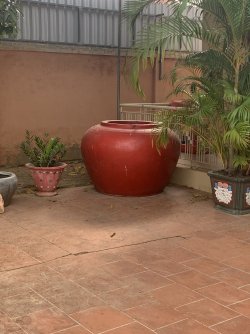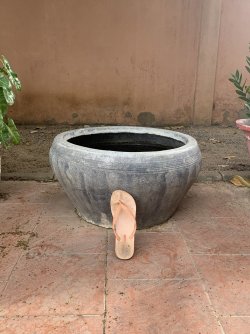A cooling off period is where the fish are kept in cool water for several months to simulate winter. Danios normally live in cool water with a temperature between 16-26C and they breed in spring as the weather warms up and gets to around 22C+.
In the tropics you won't be able to give them a cooling off period so the best you can do is sperate them for a few days and then put them together.
re: separating the fish. You only separate them for 5-7 days. If females danios are kept on their own for too long, they can become egg bound and won't be able to breed after that. Males and females have to be kept together at all times except for a short period of about 5 days (no longer than 7 days) just before they are put together for breeding.
You don't have to move both sexes out of the pot, you can remove the males and leave the females where they are. The male danios can go in with any other fish that will not attack them or be hassled by them. Male guppies might get harassed by danios but you will have to monitor them and see how they get along. Normally they should be fine.
Male danios are smaller and slim, and females are fatter and longer.
--------------------
If you are having fish, shrimp/ prawns or squid for dinner and they don't have any herbs, spices, sauces or anything else on them, you can cut some of the fish, prawn or squid into little pieces and offer that to the fish a couple of times a week. Use a pair of scissors and cut the raw or cooked prawn (without the shell) into little bits and offer a few bits at a time. Do this until the fish are no longer racing in grabbing the food as soon as it hits the water, then stop feeding and remove any uneaten food so it doesn't rot and cause ammonia problems.
Monitor the ammonia levels or do big water changes when feeding meat based foods because they can cause water quality problems that kill the fish.
Adding a small pellet or flake food is also helpful and will definitely help supplement the mozzie larvae.
You might be able to find live Rotifers, Daphnia or Moina up there. These are a small freshwater crustacean that can be fed to fish. They live in ponds and feed on infusoria and green water. You can keep them in ponds and use a fine mesh net to scoop them out and put them in tanks and ponds for the fish to eat.
The following link has information about culturing food for baby fish, including reference to green water, daphnia, infusoria and rotifers.
STARTING OUT Make sure you have a pair, (1 male + 1 female). There is nothing worse than spending your hard-earned dollars buying a couple of fish to try and breed and ending up with a pair of fish of the same sex. Let's face it, to reproduce fish you need a male and a female. Two males won't do...

www.fishforums.net
--------------------
I don't understand the question. Is it a reliable signal for what?
--------------------
Cichlids normally offer brood protection, basically they guard the eggs and baby fish for a month or so. This means most of the babies survive and get a chance to mature. The babies are also much bigger than danio or tetra fry and can eat a lot more types of food.
In a pond situation, the fish will breed continuously with no real input from you, and stop breeding when the pond has too many fish in. In your pots they would probably have a batch of fry and you would have to remove the babies when they are a month or two old and grow them up to full size or sell them as young fish.
Cichlids can have anywhere between 20 & 500+ eggs, but most dwarf cichlids like Apistogramma species only have 20-50 eggs at a time. This makes getting rid of them much easier because most shops will take 10 or 20 fish at a time. Most dwarf cichlids also sell for a few dollars so it can help to bring in a bit of extra cash simply for having a few fish in a pond.
--------------------
Unfortunately, due to inbreeding it is becoming more common. Fish that are too young often have complications during labour and die before or just after giving birth. Guppies and other livebearers should be allowed to mature before being bred and most deaths occur in young fish that are under 6 months of age. If you can let the fish get to 12 months before breeding, you don't normally lose any during labor.
Livebearers (guppies, mollies, swordtails and platies) should be kept in single sex tanks until they are at least 6 (preferably 12) months old. Unfortunately they are normally kept in mixed sex tanks at the shops and suppliers. This means the females are usually gravid (pregnant) when you get them. Subsequently most female guppies are only 3 or 4 months old when they have their first batch of babies.
Livebearers like guppies are also riddled with parasites like gill flukes and intestinal worms. Many have bacterial and protozoan infections when they come into the shops. This just adds to the problems and all new fish should be quarantined for a month and treated for gill flukes and worms while in quarantine.
Livebearers like guppies need water with a general hardness (GH) above 200ppm and a pH above 7.0. Mollies need a GH above 250ppm and a pH above 7.0. If the water is too soft and the pH below 7.0, they have problems.
Local bred guppies (fish born in your own tanks/ ponds) are usually much healthier and survive better than fish bought from shops, which have undergone numerous stress factors ranging from overcrowding, poor water quality, being bagged up, driven over bumpy roads, high temperatures, put into glass tanks, bagged up again, put on planes and flown around the world, then put into new tanks with different water, then bagged up again and sent to shops with different water, then bagged up again and taken home by the customer and put into another new tank with potentially different water. It's fish jet lag and stress on a massive scale and it's amazing any fish survive the trip from the suppliers to the home aquarium.
The following link has a more detailed explanation of the stress fish undergo when they leave the fish farm and travel around the world. It's pretty long but it might interest you.
If any of you have wondered how aquarium fish get to the local pet shop, the following will give you some insight as to what they have to go through to get from the fish farm where they are bred and raised, to the pet shop where you can buy them. The stress they go through is quite...

www.fishforums.net










